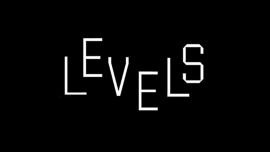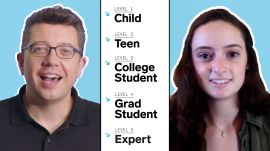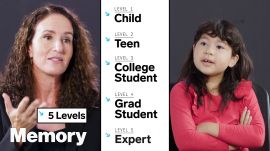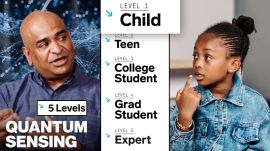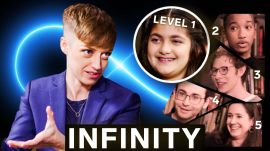5 Levels
1 season, 26 episodesCan everything be explained to everyone in terms they can understand? In 5 Levels, an expert scientist explains a high-level subject in five different layers of complexity— first to a child, then a teenager, then an undergrad majoring in the same subject, a grad student and, finally, a colleague.
Season 1
Technology
23-year-old musician, composer and multi-instrumentalist Jacob Collier explains the concept of harmony to 5 different people; a child, a teen, a college student, a professional, and jazz legend Herbie Hancock.Science
Blockchain, the key technology behind Bitcoin, is a new network that helps decentralize trade, and allows for more peer-to-peer transactions. WIRED challenged political scientist and blockchain researcher Bettina Warburg to explain blockchain technology to 5 different people; a child, a teen, a college student, a grad student, and an expert.Technology
The technology behind modern virtual reality is rapidly evolving, but what exactly helps create a better sense of realism and immersion? WIRED has challenged Oculus CTO John Carmack to explain the concept of realism in virtual reality to 5 different people; a child, a pre-teen, a college student, a grad student and a VR expert.Science
CRISPR is a new biomedical technique that enables powerful gene editing. WIRED challenged biologist Neville Sanjana to explain CRISPR to 5 different people; a child, a teen, a college student, a grad student, and a CRISPR expert.Science
The Connectome is a comprehensive diagram of all the neural connections existing in the brain. WIRED has challenged neuroscientist Bobby Kasthuri to explain this scientific concept to 5 different people; a 5 year-old, a 13 year-old, a college student, a neuroscience grad student and a connectome entrepreneur.Science
WIRED has challenged NASA's Varoujan Gorjian (Research Astronomer, NASA Jet Propulsion Lab) to explain black holes to 5 different people; a child, teen, a college student, a grad student and an expert.Science
Donna Strickland, PhD, professor at the University of Waterloo, is challenged to explain lasers to 5 different people; a child, a teen, a college student, a grad student, and an expert.Science
Sleep scientist Aric A. Prather, PhD, is challenged to explain the topic of sleep to 5 different people; a child, a teen, a college student, a grad student, and an expert.Science
Theoretical physicist Sean Carroll, PhD, is challenged to explain the concept of dimensions to 5 different people; a child, a teen, a college student, a grad student, and an expert.Science
Astrophysicist Janna Levin, PhD, is asked to explain the concept of gravity to 5 different people; a child, a teen, a college student, a grad student, and an expert. Levin is the Claire Tow Professor of Physics & Astronomy at Barnard College of Columbia University and author of "Black Hole Blues and Other Songs from Outer Space." She is also the Chair and Director of Sciences at Pioneer Works, where this video was filmed. To learn more, visit https://pioneerworks.org/Technology
Security researcher and computer hacker Samy Kamkar is asked to explain the concept of computer hacking to 5 different people; a child, a teen, a college student, a grad student, and an expert.Science
Nanotechnology researcher Dr. George S. Tulevski is asked to explain the concept of nanotechnology to 5 different people; a child, a teen, a college student, a grad student, and an expert.Design
WIRED has challenged origami artist and physicist Robert J. Lang to explain origami to 5 different people; a child, teen, a college student, a grad student and an expert.Technology
WIRED has challenged computer scientist and Hidden Door cofounder and CEO Hilary Mason to explain machine learning to 5 different people; a child, teen, a college student, a grad student and an expert.Science
WIRED has challenged neuroscientist Daphna Shohamy, PhD, to explain memory to 5 different people; a child, teen, a college student, a grad student and an expert.Science
Computer scientist Amit Sahai, PhD, is asked to explain the concept of zero-knowledge proofs to 5 different people; a child, a teen, a college student, a grad student, and an expert. Using a variety of techniques, Amit breaks down what zero-knowledge proofs are and why its so exciting in the world of cryptography. Amit Sahai, PhD, is a professor of computer science at UCLA Samueli School of Engineering.Science
Astrophysicist Janna Levin, PhD, is asked to explain black holes to 5 different people; a child, a teen, a college student, a grad student, and an expert. Special thanks to our host Janna Levin who’s literally written the book on black holes ‘Black Hole Survival Guide’ https://www.penguinrandomhouse.com/books/622603/black-hole-survival-guide-by-janna-levin/For more science and space insights follow Jann on twitter at @JannaLevinScience
Computer scientist Keenan Crane, PhD, is asked to explain fractals to 5 different people; a child, a teen, a college student, a grad student, and an expert.Technology
Dartmouth college professor Chandrasekhar Ramanathan has been tasked to explain the concept of quantum sensing to 5 different people; a child, a teen, a college student, a grad student, and an expert.Science
WIRED has challenged IBM's Dr. Talia Gershon (Senior Manager, Quantum Research) to explain quantum computing to 5 different people; a child, teen, a college student, a grad student and a professional.Science
Moravec's paradox is the observation that many things that are difficult to do for robots to do come easily to humans, and vice versa. Stanford University professor Chelsea Finn has been tasked to explain this concept to 5 different people; a child, a teen, a college student, a grad student, and an expert.Culture
The internet is the most technically complex system humanity has ever built. Jim Kurose, Professor at UMass Amherst, has been challenged to explain the internet to 5 different people; a child, a teen, a college student, a grad student, and an expert.Culture
While the concept of infinity may seem mysterious, mathematicians have developed processes to reason the strange properties of infinity. Mathematician Emily Riehl has been challenged to explain infinity to 5 different people; a child, a teen, a college student, a grad student, and an expert. Director: Maya Dangerfield Producer: Wendi Jonassen Director of Photography: Ben Finkel Editor: Louville Moore Host: Emily Riehl Level 1: Samira Sardella Level 2: Eris Busey Level 3: Yoni Singer Level 4: Elliot Lehrer Level 5: Adriana Salerno Line Producer: Joseph Buscemi Associate Producer: Paul Gulyas Production Manager: Eric Martinez Production Coordinator: Fernando Davila Camera Operator: Larry Greenblatt Gaffer: Randy Feldman Audio: Ken Pexton Production Assistant: Andrea Hines Hair/Makeup Artist: Haki Pope Johns Post Production Supervisor: Alexa Deutsch Post Production Coordinator: Ian Bryant Supervising Editor: Doug Larsen Assistant Editor: Paul TaelCulture
Time: the most familiar, and most mysterious quality of the physical universe. Theoretical physicist Brian Greene, PhD, has been challenged to explain the nature of time to 5 different people; a child, a teen, a college student, a grad student, and an expert. Director: Maya Dangerfield Producer: Wendi Jonassen Field Producer: Katherine Wzorek Director of Photography: Charlie Jordan Editor: Shandor Garrison Host: Brian Greene Level 1: Kayla Martini Level 2: Maria Guseva Level 3: Zain Kamal Level 4: Alexander Novara Level 5: Massimo Porrati Line Producer: Joseph Buscemi Associate Producer: Paul Gulyas Production Manager: Eric Martinez Production Coordinator: Fernando Davila Casting Producer: Nick Sawyer Camera Operator: Britney Berger Gaffer: Gautam Kadian Audio: Brett Van Deusen Production Assistant: Nicole Gaitan Hair/Makeup Artist: Yev Write-Mason Post Production Supervisor: Alexa Deutsch Post Production Coordinator: Ian Bryant Supervising Editor: Doug Larsen Assistant Editor: Andy MorellScience
Nuclear fusion underpins some of the most basic processes in our universe and holds the promise of virtually limitless, clean, carbon-free energy. Dr. Anne White, Professor of Nuclear Science and Engineering at The Massachusetts Institute of Technology, has been challenged to explain the nature of nuclear fusion to 5 different people; a child, a teen, a college student, a grad student, and an expert.Science
From the physical world to the virtual world, algorithms are seemingly everywhere. David J. Malan, Professor of Computer Science at Harvard University, has been challenged to explain the science of algorithms to 5 different people; a child, a teen, a college student, a grad student, and an expert. Director: Wendi Jonassen Director of Photography: Zach Eisen Editor: Louville Moore Host: David J. Malan Guests: Level 1: Addison Vincent Level 2: Lexi Kemmer Level 3: Patricia Guirao Level 4: Mahi Shafiullah Level 5: Chris Wiggins Creative Producer: Maya Dangerfield Line Producer: Joseph Buscemi Associate Producer: Paul Gulyas; Kameryn Hamilton Production Manager: D. Eric Martinez Production Coordinator: Fernando Davila Casting Producer: Vanessas Brown; Nicholas Sawyer Camera Operator: Brittany Berger Gaffer: Gautam Kadian Sound Mixer: Lily Van Leeuwen Production Assistant: Ryan Coppola Hair & Make-Up: Yev Wright-Mason Post Production Supervisor: Alexa Deutsch Post Production Coordinator: Ian Bryant Supervising Editor: Doug Larsen Assistant Editor: Lauren Worona




